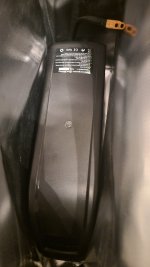SkunkyFartz
1 mW
Hello! I really need some help with this it's regarding my second sabvoton controller.
You see when I purchased my first sabvoton controller. It came with a USB Bluetooth stick. Which allowed me to use an app called MQCON to change parameters on my controller. Such as amps or other stuff. I didn't mess around with it much. The controller worked great for a year and couple months. Until some of the display wires came loose and I believe it shorted itself out. That's fine and that was totally my doing. The first controller at the time was programmed to work with a 48v set up. At the time I did have a display but it was useless had a 30H error. But I still needed it to turn the bike on and off.
So couple months later I ordered the SECOND sabvoton controller after it arrived. It worked great for a month or so. Then one evening. It hit me with an Error 02H controller protection. That's fine too. I read online that you can bypass that by lowering the Amps or something.
So what I did was I took the Bluetooth dongle from the FIRST sabvoton controller and used it on the SECOND newer sabvoton controller. Once I plugged it in it was NOT able to locate it on the app. However! after my display shuts off. I was no longer able to turn it back on!
Did I just freaking bricked my own controller? I really do not want to shell out another 200 plus dollars for another controller man. If someone could please help me find a way to fix this.
I can send images if thar helps. But it won't help much I would assume.
You see when I purchased my first sabvoton controller. It came with a USB Bluetooth stick. Which allowed me to use an app called MQCON to change parameters on my controller. Such as amps or other stuff. I didn't mess around with it much. The controller worked great for a year and couple months. Until some of the display wires came loose and I believe it shorted itself out. That's fine and that was totally my doing. The first controller at the time was programmed to work with a 48v set up. At the time I did have a display but it was useless had a 30H error. But I still needed it to turn the bike on and off.
So couple months later I ordered the SECOND sabvoton controller after it arrived. It worked great for a month or so. Then one evening. It hit me with an Error 02H controller protection. That's fine too. I read online that you can bypass that by lowering the Amps or something.
So what I did was I took the Bluetooth dongle from the FIRST sabvoton controller and used it on the SECOND newer sabvoton controller. Once I plugged it in it was NOT able to locate it on the app. However! after my display shuts off. I was no longer able to turn it back on!
Did I just freaking bricked my own controller? I really do not want to shell out another 200 plus dollars for another controller man. If someone could please help me find a way to fix this.
I can send images if thar helps. But it won't help much I would assume.


